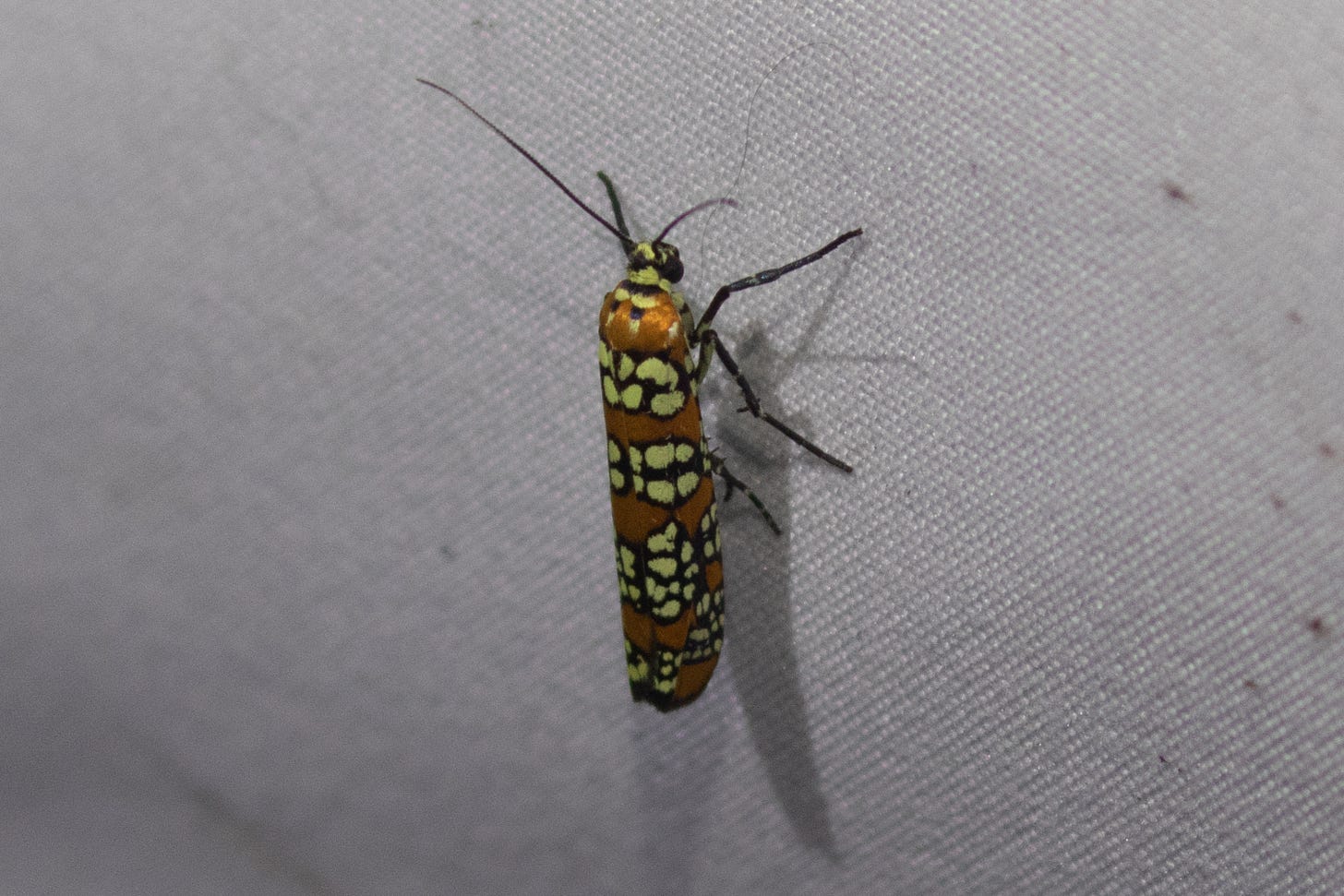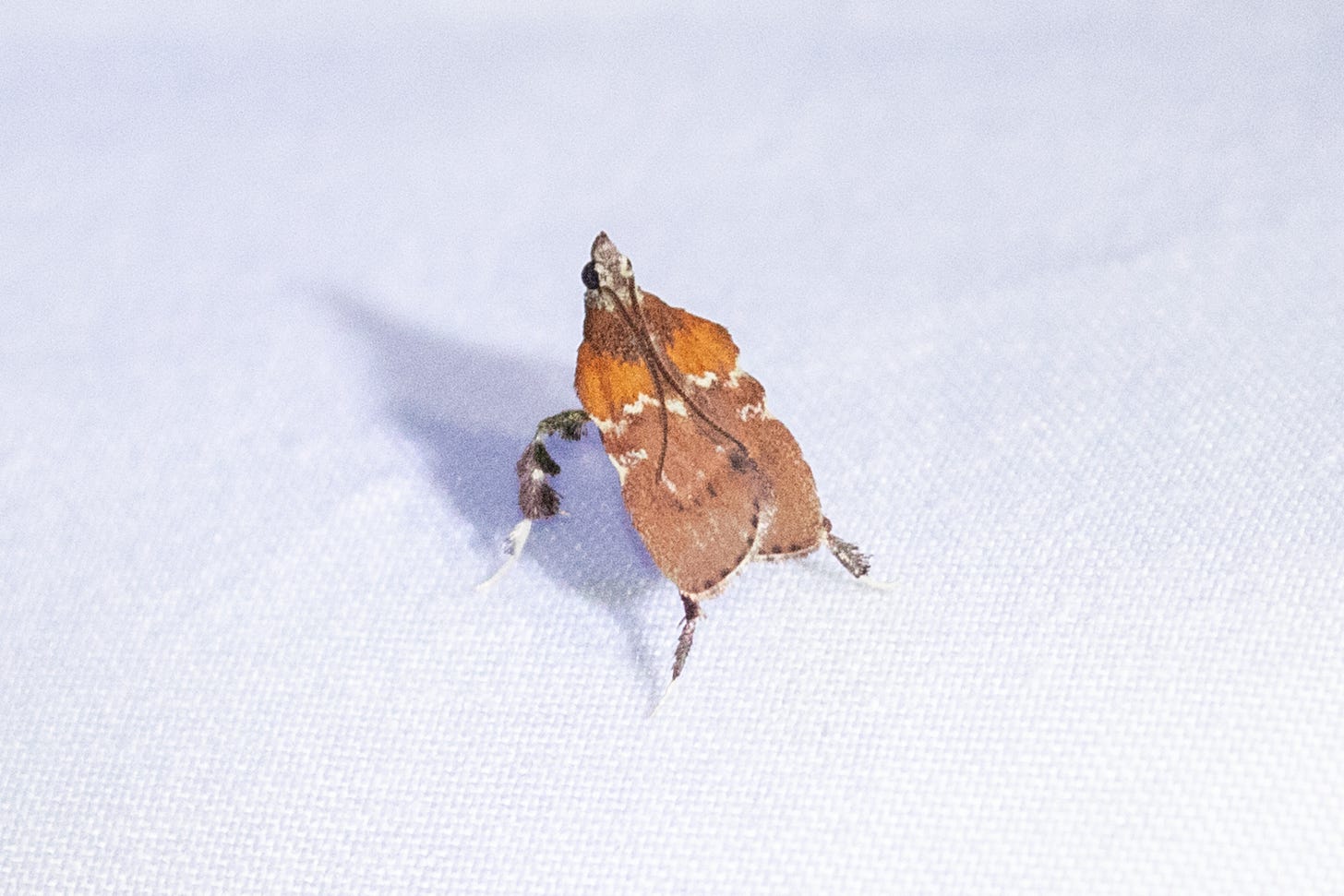the native moth named after an invasive plant
it's, like, all connected, or something
when you start looking at moths in new york city, it’s not long before you encounter an ailanthus webworm moth. it’s patterned like something from a grandma’s living room, bright orange with bands of black-bordered white spots. it flies during the day, and barely looks like a moth at all. but once you hear the name, you kinda shrug your shoulders. it’s named after one of our most common invasive trees. another insect to add to the countless list of invasive things to hate.
but things aren’t always what they seem when it comes to urban wildlife. while the moth is named after an invasive plant, humans didn’t accidentally introduce it like they did the spotted lanternfly. this moth showed up on its own. you could say it’s a “native” moth named after an invasive plant. but even that doesn’t totally capture it.
entomologist asa fitch first spotted the insect in savannah, georgia in 1857, but just as an adult. as cool as it looked, he didn’t glean much information from it—he didn’t know what it fed on, for example, which means he didn’t know where he could find another one if he wanted to.
but in 1911, philadelphia entomologist carl ilg found a web with a chrysalis inside attached to an ailanthus altissimia tree, also known as tree-of-heaven. he took the chrysalis home and it hatched into fitch’s art deco moth. ilg returned to the plant and found more of the caterpillars and chrysalises. the discovery led to the moth’s common name, the ailanthus webworm moth, according to research by independent ecologist kenneth frank published in his ecology of center city, philadelphia.
ailanthus altissima made its first appearance in the united states in the 18th century, planted by horticulturalists for its beauty. it does kind of look like something you’d see inside a casino. but today, the first word american naturalists would use to describe it is “invasive.” it crowds out native plants and changes the soil composition to make places inhospitable to the competition. it’s also the host plant of the spotted lanternfly!
we’ve got a perverse fondness for tree-of-heaven in new york. this scraggly shrub with its long fronds of leaflets can grow almost anywhere, even on sandy beaches or out of cracks in the sidewalk. its vigor makes it the central symbol of a tree grows in brooklyn.
so we have this beautiful moth that loves this invasive tree from east asia. the moth must be from east asia too, right? nope, it doesn’t appear in collections in either europe or asia. instead, this moth is native to central america, north through mexico to south florida. there, it feeds on a genus of plants called simarouba, which includes a plant in florida called the paradise tree.

ailanthus altissma and the simarouba plants are all part of a family called the simaroubaceae. evidently, the ailanthus webworm moths thought the introduced ailanthus was similar enough to their usual diet that they switched over—and followed a trail of ailanthus northward until they ended up here in new york city.
the moth doesn’t stay here, though—it can’t survive cold temperatures. so the ailanthus webworm moths we see come from moths moving north as things warm up through year, breeding along the way, then they die at the end of the year and do it again the next year. but as winters stay warmer, these moths are pushing their permanent range north, too.
there are other examples of creatures suddenly deciding they like introduced species. the boxwood leaftier moth is a moth native to northeastern noth america whose preferred host plant is boxwood—the introduced shrub used to make topiaries and perfectly rectangular hedges. no one knows what plant the boxwood leaftier moth used to eat. note that this moth is also kinda cute.
is the ailanthus webworm moth good or bad? native or invasive? i don’t know. it’s cool when a native insect likes an introduced plant. without digging too deep, i don’t think you could make any strong statements about their benefit or harm—they do pollinate flowers, though animals can’t really eat them, because insects that feed on ailanthus take up chemicals from the plants’ leaves that make them unpalatable.
but ailanthus’ harm to native ecosystems certainly outweighs the benefit of the moth liking it. and it’s always a good reminder that small changes—releasing a pet turtle in the park, using a non-native insect to control other insects, or planting a tree because it looks kinda tropical—can have strange, unexpected consequences on our native ecosystems. new york city, an immense sum of these small changes, is therefore a host to a number of these unexpected consequences.
postscript
i’m leading a walk TODAY, april 17, meeting at brooklyn’s grand army plaza arch at 5:30pm. it’ll be quick, maybe 45 minutes, because i have to rush up to astoria to lead a bird trivia.
a few things are in flight for me right now. migration is in full swing, so i’m out birding every morning. my book draft is due in three months and i’ve got a lot of writing left - this blog post is sort of an excerpt from the book draft, except my book will have proper capitalization and will be more field guidy and less opiniony. i have articles drafted that should be out in the next few months, one of which will be my longest print feature yet!
looking forward to sharing that stuff with you all. but for now, here’s a piping plover.





